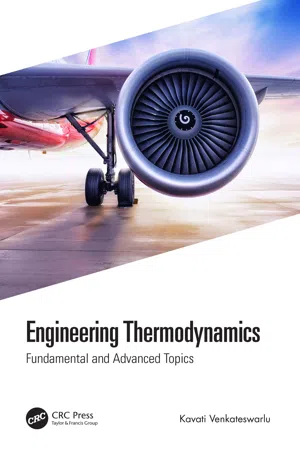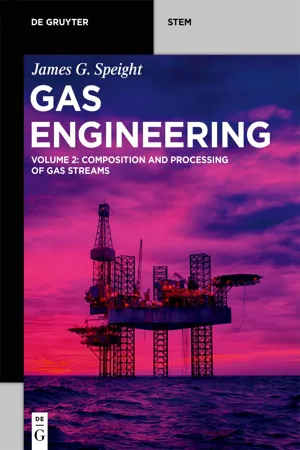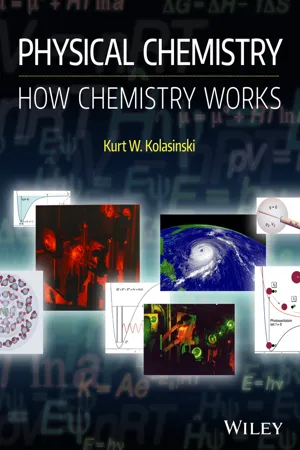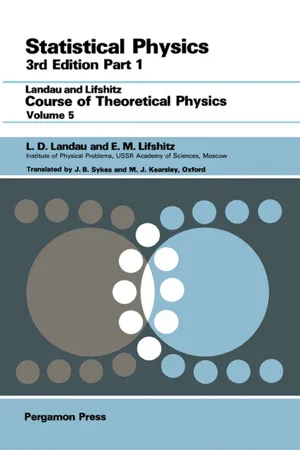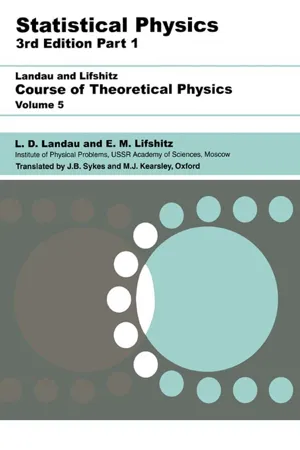Chemistry
Real Gas
A real gas is a gas that does not behave exactly according to the ideal gas law at all conditions, particularly at high pressures and low temperatures. Unlike ideal gases, real gases have volume and experience intermolecular forces. These deviations from ideal behavior are accounted for using the van der Waals equation or other more complex equations of state.
Written by Perlego with AI-assistance
Related key terms
Related key terms
1 of 4
Related key terms
1 of 3
5 Key excerpts on "Real Gas"
- eBook - ePub
Engineering Thermodynamics
Fundamental and Advanced Topics
- Kavati Venkateswarlu(Author)
- 2020(Publication Date)
- CRC Press(Publisher)
In reality, there seems to be no gas that behaves like an ideal gas or a perfect gas. The Real Gases such as oxygen, hydrogen, nitrogen, and air are assumed to behave like a perfect gas at very low pressures or very high temperatures.8.2 Other Equations of State
Van der Waals Equation of State
The kinetic theory of gases, proposed by Clerk Maxwell, forms the basis for establishing the ideal gas equation of state. The ideal gas equation is developed based on certain assumptions as given below:- The molecules of a gas are spaced apart that there is little or no attraction between them.
- The volume occupied by the molecules themselves is quite low compared to the volume of gas.
- Molecules are in random motion, which follows Newton’s law of motion.
- The kinetic energy of the molecules and their momentum are conserved as molecules and walls of the container are perfectly elastic.
The Real Gases do not obey the assumptions made in the kinetic theory of gases. At very low pressures or very high temperatures, Real Gas obeys the ideal gas equation as intermolecular attraction and volume occupied by molecules compared to the total volume are not considered at this state. When the pressure increases, intermolecular forces increase and the volume of molecules becomes considerable when compared to that of gas. Thus Real Gases deviate from the ideal gas equation of state appreciably with an increase in pressure. Van der Waals introduced two correction factors ‘a’ and ‘b’ in the ideal gas equation, first one to account for intermolecular attraction and the second one to account for volume of molecules. The Van der Waals equation is(8.5)(p +)aν 2(= R Tν − b)the termais called the force of cohesion and b the co-volume. At high pressures, all Real Gases obey the Van der Waals equation of state; however, it is not true at all ranges of pressures and temperatures. Table 8.1ν 2 - eBook - ePub
Gas Engineering
Vol. 2: Composition and Processing of Gas Streams
- James G. Speight(Author)
- 2022(Publication Date)
- De Gruyter(Publisher)
The gas laws are derived from the following assumptions and which relate to the kinetic–molecular theory is based on the following assumptions: (1) a gas consists of tiny particles, either atoms or molecules, moving about at random, (2) the volume of the particles themselves is negligible compared with the total volume of the gas, (3) the gas particles act independently of one another; there are no attractive or repulsive forces between particles, (4) collisions of the gas particles, either with other particles or with the walls of a container, are elastic so that the total kinetic energy of the gas particles is constant at constant temperature, and (5) the average kinetic energy of the gas particles is proportional to the Kelvin temperature (in Kelvin, K) of the sample. Beginning with these assumptions, it is possible not only to understand the behavior of gases but also to derive quantitatively a series of laws leading to the derivation of the ideal gas law.Thus, by definition, gases are the state of matter in which the molecules are far apart from each other and are characterized by a lack of definite volume and density. The following laws (listed alphabetical rather than by any preference) are (1) Avogadro’s law, (2) Boyle’s law, (3) Charles law, (4) Gay-Lussac’s law, (5) Graham’s law, and (6) the ideal gas law; these laws provide the relation between mass, pressure, volume, temperature, and density of ideal gas molecules.Gases, unlike solids and liquids, show similar physical behavior regardless of the chemical makeup of the gas. Form this behavior, the properties of any gas can be defined by four variables, namely (1) the pressure, P, (2) the temperature, T, (3) the volume, V, and (4) the number of moles, n, and the specific relationships among these four variables form the basis for the gas laws and, consequently, an ideal gas is a gas whose behavior follows the gas laws.There are two types of gases: an ideal gas and a nonideal gas. An ideal gas has the following properties: (1) there are no intermolecular forces between the gas particles, (2) the volume occupied by the particles is negligible compared to the volume of the container they occupy, and (3) the only interactions between the particles and with the container walls are perfectly elastic collisions.An ideal gas can be characterized by three variables which are (1) the absolute pressure, P, (2) the volume, V, and (3) the absolute temperature, T. Thus:P V = n Z R TTypically, in this equation, P is the pressure, V is the volume, T is the absolute temperature in Kelvin, Z is the compressibility, n is the number of kilomoles, and R - eBook - ePub
Physical Chemistry
How Chemistry Works
- Kurt W. Kolasinski(Author)
- 2016(Publication Date)
- Wiley(Publisher)
CHAPTER 3 Non-ideal gases and intermolecular interactionsPREVIEW OF IMPORTANT CONCEPTS
- The cause of non-ideal behavior is intermolecular interactions.
- There are a number of interactions that change the energy of molecules and ensembles of molecules. Many are electrostatic in nature and therefore depend on the distance between particles.
- Anything that takes a molecule away from the condition ‘neutral with a spherical charge distribution’ will lead to increased intermolecular interactions.
- A multipole expansion can be used to approximate the charge distribution and interaction energies between molecules as long as their orbitals are not overlapping.
- Some examples of long-range interactions include charge–charge, charge–dipole, charge-induced dipole, dipole-induced dipole, and higher multipole interactions.
- Short-range interactions include chemical bonding, hydrogen bonding and Pauli repulsion.
- A virial expansion represents an approach to represent the equation of state of a Real Gas.
- Another approximation to the equation of state of a Real Gas is the van der Waals equation.
- Consequences of non-ideal behavior include not only a change in the equation of state but also that gases can condense into condensed phases with finite volumes.
- A supercritical fluid exists above the critical temperature Tc and cannot be condensed merely by compression at or above Tc .
- If the pressure, temperature and volume are expressed as reduced properties, then the equation of state is the same for all gases. The reduced properties are obtained by dividing the property by its critical value. This is known as the law of corresponding states.
3.1 Non-ideal behavior
Whereas all gases act ideally at low pressure where they are on average far from each other, all gases act non-ideally as they approach conditions that promote condensation. At low enough T and high enough p, Real Gases should condense into a liquid. Indeed, at 1 atm and low enough T every element except He condenses into a liquid. He condenses into a solid at 1 atm and requires p - eBook - ePub
- L. D. Landau, E. M. Lifshitz(Authors)
- 2013(Publication Date)
- Pergamon(Publisher)
CHAPTER VIINON-IDEAL GASES
Publisher Summary
The equation of state of an ideal gas can often be applied to actual gases with sufficient accuracy. However, this approximation may be inadequate, and it is necessary to take account of the deviations of an actual gas from the ideal state that result from the interaction between its component molecules. In gases, the interaction among molecules is very weak. As this interaction increases, the properties of the gas differ more and more from those of ideal gases, and finally, the gas condenses into a liquid. In the latter, the interaction among molecules is strong, and the properties of this interaction and, therefore, those of the liquid depend considerably on the particular liquid concerned. When the density increases and the gas approaches the liquid state, it must take account of the finite compressibility of the substance. This chapter discusses the deviations of gases from the ideal state, Van der Waals’ formula, the Debye-Hückel method, the method of correlation functions, and the thermodynamic quantities for a degenerate plasma.§ 74. Deviations of gases from the ideal state
The equation of state of an ideal gas can often be applied to actual gases with sufficient accuracy. This approximation may, however, be inadequate, and it is then necessary to take account of the deviations of an actual gas from the ideal state which result from the interaction between its component molecules.Here we shall do this on the assumption that the gas is still so rarefied that triple, quadruple, etc., collisions between molecules may be neglected, and their interaction may be assumed to occur only through binary collisions.To simplify the formulae, let us first consider a monatomic actual gas. The motion of its particles may be treated classically, so that its energy has the form - eBook - ePub
Statistical Physics
Volume 5
- L D Landau, E.M. Lifshitz(Authors)
- 2013(Publication Date)
- Butterworth-Heinemann(Publisher)
CHAPTER VIINON-IDEAL GASES
Publisher Summary
The equation of state of an ideal gas can be applied to actual gases with sufficient accuracy. This approximation may be inadequate, and it is necessary to take account of the deviations of an actual gas from the ideal state, which results from the interaction between its component molecules. In gases the interaction between molecules is weak. As this interaction increases, the properties of the gas differ from those of ideal gases and the gas condenses into a liquid. In the latter, the interaction between molecules is strong, and the properties of this interaction depend on the particular liquid concerned. For this reason, it is impossible to derive any general formulae giving a quantitative description of the properties of a liquid. An interpolation formula provides a qualitative description of the transition between the liquid and gaseous states. This formula must give the correct results in the two limiting cases. Such a formula also gives a qualitative description of the behavior of the gas in the intermediate range.§ 74 Deviations of gases from the ideal state
THE equation of state of an ideal gas can often be applied to actual gases with sufficient accuracy. This approximation may, however, be inadequate, and it is then necessary to take account of the deviations of an actual gas from the ideal state which result from the interaction between its component molecules.Here we shall do this on the assumption that the gas is still so rarefied that triple, quadruple, etc., collisions between molecules may be neglected, and their interaction may be assumed to occur only through binary collisions.To simplify the formulae, let us first consider a monatomic actual gas. The motion of its particles may be treated classically, so that its energy has the form(74.1)where the first term is the kinetic energy of the N atoms of the gas, and U is the energy of their mutual interaction. In a monatomic gas, U is a function only of the distances between the atoms. The partition function ∫e−E(p,q)/T
Index pages curate the most relevant extracts from our library of academic textbooks. They’ve been created using an in-house natural language model (NLM), each adding context and meaning to key research topics.
Explore more topic indexes
Explore more topic indexes
1 of 6
Explore more topic indexes
1 of 4
